Executive Summary
The main objectives of this study is to assess the market condition of a notebook computer as a new product and try to generate an idea for introducing a notebook computer in Huawei’s current product portfolio. Firstly, the report analyzes the current notebook market with its major players in the market and then it focuses on developing a strategy for Huawei to enter into the notebook market and implement those strategies to attain a market edge. After that, the report analyzes the quality issues in Huawei’s notebook and different aspects of quality. It also engages to explore various considerations related to the location selection. Process selection and analysis are other aspects of the study. It shows the guideline for selecting suppliers with a mathematical solution. Finally, the report provides a composite plan for implementing the projects.
Introduction
Huawei is a China-based global company that mainly doing business in the telecommunication sectors with substantial growth in the market located in Bantian city of China. The vision of the company is to enrich life with communication accompanied by missions to provide a high-quality product to the customers and customer base operations. The product portfolio of Huawei includes various network components like mobile networks, optical networks, etc. Currently, it plans to enter into the notebook market though they are new in the notebook market.
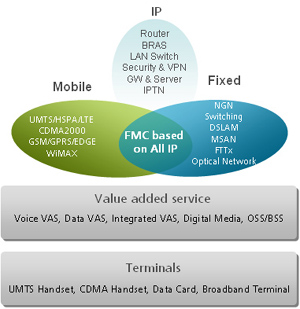
Situation and market analysis
Ruiterbos (3) pointed out that ten to twenty years ago, China was unknown to the rest of the world, and by this time today, it is one of the largest economies in the world. China has its natural resources and one of the major forces of production, abundant human resources including more than one billion populations, which make the main economic base for the country. Notebook is one of the popular products of China and almost all manufacturer of notebook computer set their factory in China. Huwai is one of the big manufacturers of mobile network appliances doing business worldwide. This section of the paper explores the current market trends of a notebook computer with the major competitors in this market. It also focuses on the microenvironment of China for establishing this product (Bhattacharyya, 3).
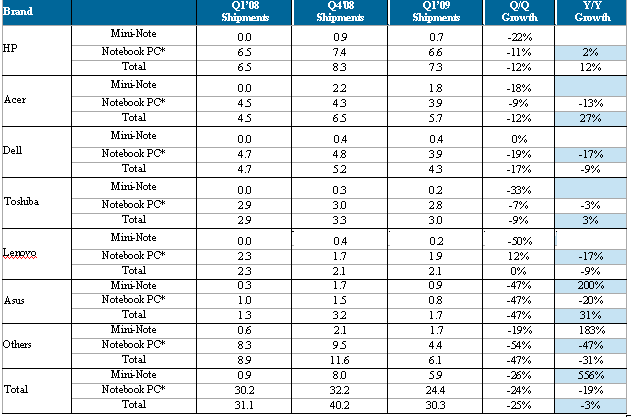
The major players of a notebook computer in China are as follows:
- HP: Currently HP produces different types of notebook computers for different types of users. The production facilities of HP for producing notebooks locate in China. They are a major market shareholder in this region.
- ACER: Acer also produces notebook computers in China and has a low price for their product. They are also popular in the notebook market and gained a good customer base.
- MITSUBISHI: Mitsubishi is originally a Taiwan company popular for their automobile but now they produce notebook computers and competes in the Chinese market.
- PHILIPS: Philips mainly produces television for the consumers and has a good reputation in the market. Currently, they produce notebook computers in China and compete in the market.
Besides these companies, there are also other companies like Dell, Toshiba, Lenovo; Fujishu, etc. also compete in the market (marketing plan- Gigabyte).
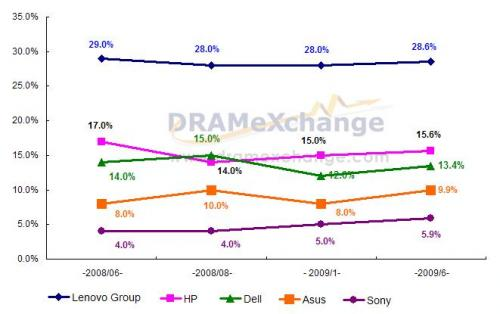
In the world market, HP grabs the major market shares, and after that Dell is in the second position. On the other hand, in the Chinese market Acer place in the second position. One thing that must consider is that whatever the companies’ country of origin, the companies face competition on a global scale (Cuizon, 5).
Implementation strategy
Target market: Huawei’s target markets include two types of customers and their notebook computers will be design based on these two market segments (Co, 1).

Corporate user: Corporate users include those who buy a notebook for their official purposes and purchase a notebook on a lot basis.
End-user: End users are the general customers of the notebook computer who buy this product for their uses and purchase only a single piece. These customers are important from Huawei’s perspective, as they constitute the main customer base for the company (Docstoc.com, 1).
Mission
The mission of the Huawei Notebook is to provide a quality product in the market at a competitive price and contribute to the growth of the Chinese economy.
Objectives
- Provide the best quality notebook in the market
- Maintain competitive price for their notebook computer.
- Enter different segments in the market.
- Increase the market share of the company.
- Take the position of the market leader within two to three years.
- Increase the market on a global basis.
Strategies to achieve the objectives
- Cost: Xiaojie (2006) described that Notebook computer trends show that the competition is mainly base on the price as players of the market introduce low price notebooks to capture more market.
- Quality: To establish a brand in the market, the prerequisite is quality, and even price-sensitive segments of the market are also aware of the quality.
- Time: Time is an important issue in the supply chain, as the supply of products on time is crucial for the fast enters and exists in the market.
- Flexibility: The notebook and information and technology market is more diverse than any other sector. Flexibility is very important because the market is changing rapidly (Scribd, 1).
- Reliability: Reliability is an important issue as Huawei must ensure reliability through the after-sales services and other promotional techniques and establish the brand in the market (Subramanian, 5).
- Creativity: The R & D team of Huawei must be able to produce a new design of the notebook computer to expand the market. Creativity is a very crucial matter in this regard, as more new product enhances the chance of success (Huawei, 2).
Huawei should consider the above-mentioned issues when formulating a strategy.
Product/service quality design and production process
When Huawei going to produce their product design they need to consider some points related to the product design (Stevenson, 1). They are as follows:
- Product life cycle: The notebook computer is a new product in the market especially in developing countries and certainly, it stands in its growth stage (Spencer, 2).
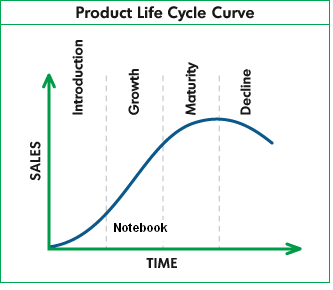
- Manufacturing Design: To design the notebook, Huawei must consider its capabilities and resources not only in product design but also in the assembly design. It is compatible for the company to outsource the semiconductor and establish an assembly plan for the company.
- Remanufacturing: This design includes changing some features or parts of the product to update the product without changing the total system. This design should integrate with the plant of Huawei as notebooks are updating nearly every month.
- Robust Design: Huawei should include more resistance power in their design for the prevention of environmental influences that means its product designs and processes create in a way that the response to the change in the environment must be quick and reliable.
- Concurrent Engineering: Huawei must involve its production teams in the product design so that these people can develop the production process simultaneously with the design of the product.
- CAD: Computer-Aided Design is compulsory for the modern production plans so that Huwai must develop the graphical design for their plant, which gives them the easy alteration of the design in case of emergency.
Competitiveness of Huawei Notebook
Competitiveness is the major force in the market and parameter for whether Huawei can do business in the Chinese market or not. This competition of notebook computers in the market takes in many ways, which Huawei must take into consideration of Price, Quality, Time, and Competitiveness Index.
Huawei also considers two basic issues regarding the competitiveness that what customer wants from the company and how these values deliver to the customers. These value relationships express in the following index.


Using the above index Huawei can weighting on the different components of the value index and must set a benchmark for each of the factors like quality, speed, flexibility, etc.
Factors of Location Planning
When Huawei selects the location for their new plant of a notebook computer, they need to consider this regard. Stevenson (2005) also suggests that.
- Regional Factors: Regional factors are based on three assumptions, which are the location of raw materials, the location of the market, the availability of the labor force. Huawei should consider these factors in selecting the locations.
- Community Factors: Community factors related to the facilities of the location includes the presence of schools, colleges, shopping facilities, etc. The size of the community, attitudes of the community towards the company, tax rates, and environmental regulations, availabilities of utility services are major considerations. Huawei must consider those factors in selecting the location.
- Site-related factors: Huawei firstly consider the quality of land which includes the soil of the land, architectural evaluation, development cost, etc., and the cost of transportation which includes the facilities of ports or shipment, the physical condition of the road, availability of transport vehicles, etc.
Selection of Location
The fixed and variable cost of the alternative location:

Solution
In cost analysis, the calculation of total cost is following:
Total Cost = Fixed Cost + Variable Cost x Quantity or volume of output:
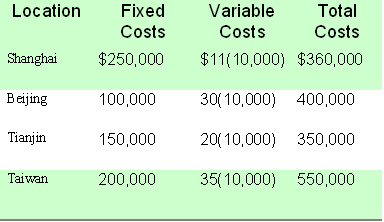
Plotting of total cost line with the number of output:
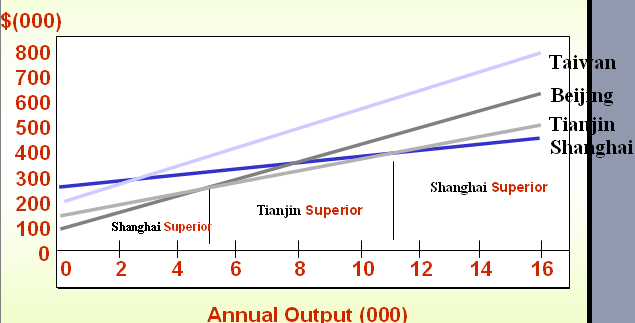
Cost-volume-Profit: In this figure, it shows that Shanghai is the best location for producing five thousand units whereas Tianjin is the best location for producing eight thousand units and finally Shanghai is the best location for producing more than eleven thousand units. On the other hand, Taiwan does not consider for it higher fixed cost for the lower level of production.
Factor Rating
It is a weight method for evaluating the alternatives based on some relevant factors and weight on each factor to determine the best alternatives. Finally adding all the weight, evaluate the alternatives, which alternative gets the best weight selects for the plant. Huawei can use this method for its location selection.

Through this analysis, Huawei can estimate the best alternatives by putting weight into different factors and it helps Huawei to assess the transportation cost with its relative merits or demerits.
Research and development for the new product production system design is as:
Process Selection
Process selection includes some strategic decisions of the company about the making or buying of components of the new product or the whole product (Klein, 3). Huawei is a telecommunication company and they use this approach to decide about outsourcing or making the component of the notebook. Here a hypothetical calculation buying decision is given-
For Huawei’s Notebook Plant the estimated cost are as follows:

- Total Cost = Fixed cost + Volume X Variable cost per unit
- So, Make= $900000 + 72000 X $360 = $26820000
- Buy = 0 + 72000 X $480 = $34560000
From the calculation, it observes that making is more profitable than the buying of the products for Huawei.
Capacity Planning
Capacity refers to the higher production ability of a plant or facility. Huawei wants to enter the notebook market and the product is in the growth stage, as a result, it must concentrate on its capacity for future increase production. Capacity planning includes the planning on what kind of capacity it needed, how much needed at which time. To measure the capacity of the Huawei notebook plant they can use some tools for measuring capacity. There are two types of capacity firstly design capacity and secondly effective capacity. (TeamQuest, Corporation, 2)
Capacity can be measure in two disciplines, which are efficiency and utilization.


Suppose, for Huawei Notebook Plant the Design Capacity is 100 notebooks per day.
The effective Capacity is 80 notebooks per day.
The actual Output is 72 notebooks per day.
Therefore, the capacity per day will be:

Work Design
It refers to the specification of the elements of the work or job and identifies the method of performing the work. It is very important for getting efficiency in the job and increasing the productivity of the work. Huawei must carefully design the work for the expected efficiency and productivity. It is important to determine the requirements of time for doing a specific job. Stopwatch time study is a popular tool for estimating the average time required for performing a specific job.
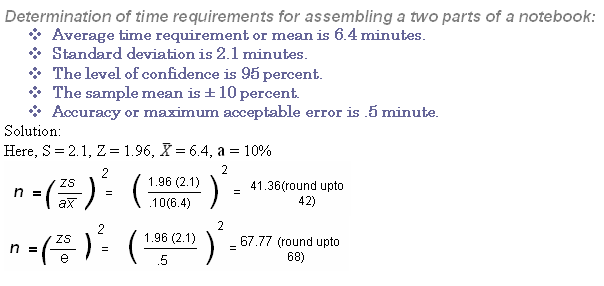
Quality Assurance Scheme
Quality refers to perception about the product to the customer, in other words, the ability of the products to satisfy the specific needs of the customers. To get success in the notebook market Huawei must concentrate on some dimension of the quality of the products. These are as follows:
- Performance: It refers to the core characteristics of the product for which customers normally buy the product (Umamaheswaran, 2).
- Aesthetics: It refers to the outlook of the notebook computer including color, size, etc.
- Special features: It refers to special features like web-came, Bluetooth device, Wi-Max modem, etc.
- Conformance: It refers to the meeting of the expectation of the customers by the product.
- Safety: Safety is important for a notebook computer as it is an electric product.
- Reliability: Reliability is the consistent performance of the notebook.
- Durability: Durability means the lifetime of the notebook. The warranty ensures the minimum life of the notebook.
- Perceived quality: It refers to the customer’s evaluation of quality before actual purchase. It is mainly related to the reputation of the company.
Quality control technique
Mean Chart: it also refers to an x bar chart that estimates the quality of the product is limit or out of limit. An example of a mean chart will clear the concept.
The quality inspector of the Huawei notebook plant took five samples with four observations, of the length of time to process a chip of the notebook (Wiley.com, 1). The inspectors computed the mean of each sample and then computed the grand mean. All values are in minutes. He uses three-sigma control limits for future times. It shows inexperience that the standard deviation of the process is.02 minutes.
Sample



![]()
With z = 3 and n = 3 and σ =.02, the Upper Control limit and Lower control limit is:
![]()
![]()
Here:
![]()
![]() = Standard deviation of the distribution of sample means.
= Standard deviation of the distribution of sample means.
- σ = Process standard deviation
- n = Sample size
- z = Standard normal deviate
x¯ = Average of sample means
![]()
![]()
Huawei should maintain the quality by limiting the error to the ULC to LCL.
Supply Chain Management
According to Wailgum (1), Supply Chain Management is all the activities of the company from collecting raw materials for production to delivers the product to the final customer. It is very important for Huawei, as the notebook market is broadly based on the efficient handling of suppliers. Huawei must consider the following issues when selecting the suppliers.
- Lead times and on-time delivery: Huawei choose those suppliers, which provide reasonable lead-time for supplying the products, on-time delivery, and documentation regarding the quality issues (Kotler, 214).
- Quality and quality assurance: Huawei should consider the quality system of the suppliers that is what kind of quality control tools are used by the suppliers and documentation regarding the quality and quality problem and regular investigation of quality.
- Flexibility: The flexibility of the suppliers is very important as the capacity of the suppliers to respond to the market in a change in order (Physorg.com, 1).
- Location: Huawei should select those suppliers who are located near to the company as it has some advantages over the far suppliers.
- Price: Huawei should consider the relative price offering among the suppliers. Another crucial matter regarding price is whether the supplier has the willingness and effort to reduce the cost.
- Product change: It refers to the notification made by the supplier in case of any change in the product and it is important for Huawei, as it needs to prepare for this kind of alteration.
- Reputation and financial stability: Huawei should select those suppliers who have a reputation in the market and who have the strong financial capability. Otherwise, the risk will be greater.
In supply chain management an important issue is the shipping time that is the cost of shipping compared with the cost of holding the product. It will be clear by the example.
For Huawei, the annual holding cost is 20% of the unit price and the unit price of notebook $5000. The freight charges for alternatives are as follows:

Here:
- H = annual holding cost for the item
- d = time saving in days
- H =.20($5000) = $1000
- d = 5 days – 2 days = 3 days.
Cost Saving = $350 – $300 = $50
![]()
Here, the added cost to hold the item is less than the cost of saving $50. Hence, Huwai should use 5 days shipping.
Project Schedule
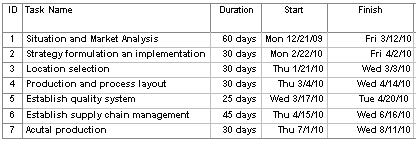
Conclusion
Huawei is a very big organization in china and they have a good capacity and reputation in the world telecom market. Through a series of analyses on different aspects of future operation, it is clear that Huawei can make a better advancement in the Notebook market as the current market is in the growth stage. Market trends show that the competition in the notebook market is mainly based on price and quality and any company that can offer a quality product with a price lower than the competitor can get success. Throughout the report, different analyses are given for the purpose to ease the set up of the new plants for Huawei in the china region.
Works Cited
Bhattacharyya B. Analyses on Chinese Economy. 2005. Web.
Co Henry. Design of People System. 2005. Web.
Cuizon, Gwendolyn. SWOT Analysis of Dell Computers. 2009. Web.
Docstoc.com. Management Situation Analysis, U.S. Department of the Interior. 2008. Web.
Huawei. Corporate information, Product portfolio. 2009. Web.
Klein, Peter. The Make-or-Buy Decision: Lessons from Empirical Studies. 2005. Web.
Kotler, Philip. Kevin Lane Keller. Marketing management. 13th ed. New Jersey: Pearson Prentice Hall. 2006. Print
Physorg.com. Basic Tools for Process Improvement: Control Chart.” 2005. Web.
Physorg.com. Strong laptop growth was seen in China. 2005. Web.
Ruiterbos, Glenheath. The Chinese Economy. 2005. Web.
Scribd. Marketing Plan of GIGABYTE Notebook. 2009. Web.
Spencer, Tom. Product Life Cycle model. 2009. Web.
Stevenson J. William. Operations Management, Location Planning, and Analysis. 2008. Web.
Stevenson J. William. Operations Management. New York: McGraw-Hill Companies. 1999. Print
Subramanian Arvind, Chinese Competition Challenges, and Opportunities. 2003. Web.
Teamquest. How to Do Capacity Planning. 2007. Web.
Umamaheswaran Aswini, et al. Indian Laptop Market. 2008. Web.
United Press International. Strong laptop growth is seen in China. 2005. Web.
Wiley.com. Cost Volume Profit Analysis. 2004. Web.
Xiaojie Zhang. Competition Intensifies in China’s Consumer Electronics Market. 2006. Web.
